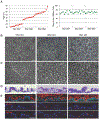Unlimited expansion of intestinal stem cells from a wide range of ages
- PMID: 31463081
- PMCID: PMC6713279
- DOI: 10.15761/IMM.1000375
Unlimited expansion of intestinal stem cells from a wide range of ages
Abstract
The recent technical advance in cloning and culturing ground-state intestinal stem cells (ISC) provides us an opportunity of accurate assessment of age-related impact on the function of highly proliferative intestinal stem cells. Our ability of indefinitely and robustly expanding single-stem-cell derived pedigrees in vitro allows us to study intestinal stem cells at the clonal level. Interestingly, comparable number of ISC clones was yielded from 1mm endoscopic biopsy of all donors despite the age. They were passaged in vitro as pedigrees and expanded to 1 billion cells in approximately sixty days without changes in stemness demonstrated by clonogenicity and multipotency. Therefore, our study shows that ISCs from a wide range of ages can be cloned and expanded to unlimited number in vitro with similar efficiency and stability. These patient-derived ISCs harbor intrinsic immortality and are ideal for autologous transplantation, supporting the promise of adult-stem-cell based personalized medicine.
Conflict of interest statement
Conflicts of interest statement W.X., F.M., M.D. and M.V have filed a patent related to the technology used in the present work and Drs. Xian and McKeon have financial interests in MultiClonal Therapeutics Inc.
Figures


References
-
- De Luca M, Pellegrini G, Green H (2006) Regeneration of quamous epithelia from stem cells of cultured grafts. Regen Med 1: 45–57. [Crossref] - PubMed
-
- Gallico GG, O’Connor NE, Compton CC, Kehinde O, Green H (1984) Permanent coverage of large burn wounds with autologous cultured human epithelium. New England Journal of Medicine 311: 448–451. - PubMed
Grants and funding
LinkOut - more resources
Full Text Sources
Other Literature Sources
